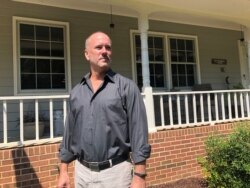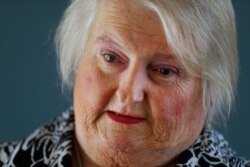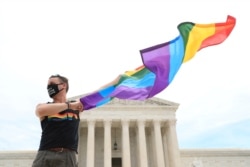For LGBTQ rights activist Jerame Davis, the U.S. Supreme Court’s historic ruling Monday banning workplace discrimination based on sexual orientation and gender identity is all too personal.
In 1999, Davis, then 24, was an assistant manager at a grocery chain store in Bloomington, Indiana.
At a corporate meeting, store manager Bill Browning, now Davis’ husband, suggested the company “expand its nondiscrimination” policy to include gays and lesbians.
Within days, Browning was fired. After criticizing the firing, Davis said, he was also let go. A few days later, another gay store clerk was forced to quit amid “the new management’s anti-gay taunts and jeers,” according to Browning’s account.
Though the city of Bloomington had passed a nondiscrimination ordinance that protected gays and lesbians, under Indiana state law, their firing was perfectly legal.
“So, when we looked for help, we couldn't find help,” Davis recalled. “No lawyer would take our case.”
Their only legal recourse was a complaint with the local human rights commission. But it took days of picketing outside the store by gay rights activists and union members for the company to offer a settlement.
In those days, Davis said, the settlement was a rarity.
“To be able to negotiate with this company and have some kind of settlement that both sides could be happy with, that wasn't the norm,” he said. "That wasn't what happened to most LGBTQ people.”
The incident pushed Davis into LGBTQ rights activism, a decades-long campaign by his group, Pride At Work, and many other organizations that activists say led to Monday's historic ruling. Davis is executive director of Pride At Work, which was founded in 1994.
Although Indiana and 28 other states do not have laws prohibiting workplace discrimination against LGBTQ workers, the Supreme Court decision means employers cannot discriminate anywhere in the country.
“The existence of this clear mandate that federal law requires employers to treat you fairly and equally is an incredibly important tool that we now need to make sure its protections are made real for people on the ground,” said Karen Lowey, senior counsel at Lambda Legal, the nation's largest LGBTQ legal organization.
Lambda filed briefs in support of three fired workers at the center of the Supreme Court decision.
Two of the plaintiffs — Gerald Bostock and Donald Zarda — were fired for being gay. The third, Aimee Stephens, lived as a man when she was first hired as a funeral director. She lost her job after announcing she planned to “live and work full time as a woman.”
Their employers, backed by the Trump administration, argued that the word “sex” as used in the 1964 Civil Rights Act "does not include sexual orientation or gender identity.”
The Supreme Court disagreed. Writing for the majority, Justice Neil Gorsuch, a conservative textualist appointed to the bench by President Donald Trump, wrote that an “employer who fires an individual merely for being gay or transgender” violates Title VII of the civil rights law.
To many LGBTQ activists, the ruling by the majority-conservative court was a stunner. Yet, the 172-page opinion was a very conservative one, Lowey said.
“It is rooted entirely in the statutory text as is appropriate when you're interpreting a law and really recognize that you cannot disaggregate a worker's sex from the discrimination that they experience when they are LGBTQ,” Lowey said.
Prior to Monday, the court’s most significant ruling on LGBTQ rights was its 2015 decision recognizing same-sex marriage as constitutionally protected.
In practice, though, this week’s anti-discrimination ruling will have a greater effect on people's lives, according to some activists.
"Not everyone is going to get married, but everyone has to get a job," Davis said.
According to a 2017 Gallup study, 4.5% of Americans are lesbian, gay, bisexual or transgender. While most employers have embraced their own anti-discrimination policies in recent years, the ruling sends a “message of values” across the board, Davis said.
Years in the making
The groundwork for Monday’s ruling was laid more than two decades ago when the court began what Lowey called a "trajectory of increasing recognition of equal dignity and humanity of LGBTQ people."
In 1996, it struck down a Colorado statute that prevented cities from passing anti-discrimination protections for gays and lesbians.
In 2003, in a reversal of a 1980's opinion, the court eliminated sodomy laws in the United States.
In 2013, it annulled a federal law that defined marriage as “the legal union between one man and one woman as husband and wife.”
Finally, in a historic decision in 2015, the justices voted 5-4 to make same-sex marriage legal in the United States.
With these rulings, federal courts “really started to grapple more in earnest with the way in which discrimination against LGBTQ workers really functions as a form of sex discrimination,” Lowey said.
Along the way, LGBTQ rights advocates suffered some setbacks. In 2018, the court sided with a Colorado baker who refused to make a wedding cake for a gay couple.
While celebrating Monday’s rulings, LGBTQ rights advocates say their work is not done. They are now pressing Congress to pass the Equality Act, which protects LGBTQ people from discrimination in employment, housing, credit, education and jury service. The House passed the bill last year, but the Senate has not adopted its own version.










